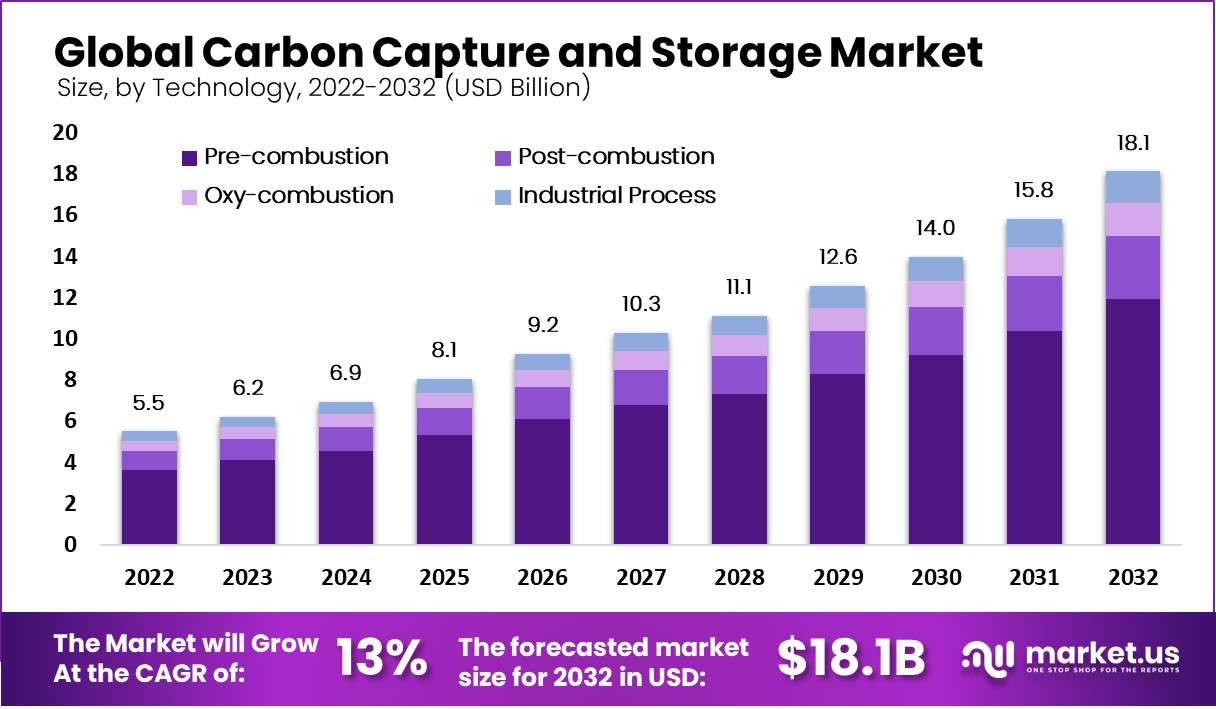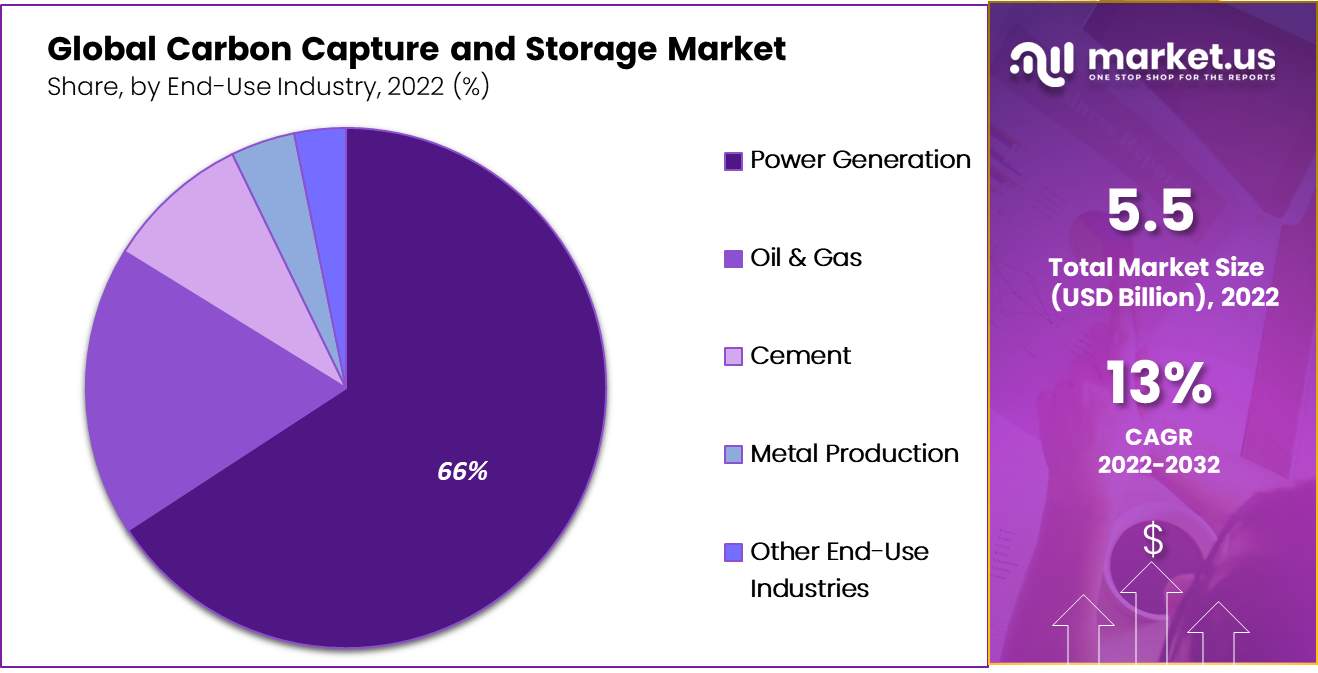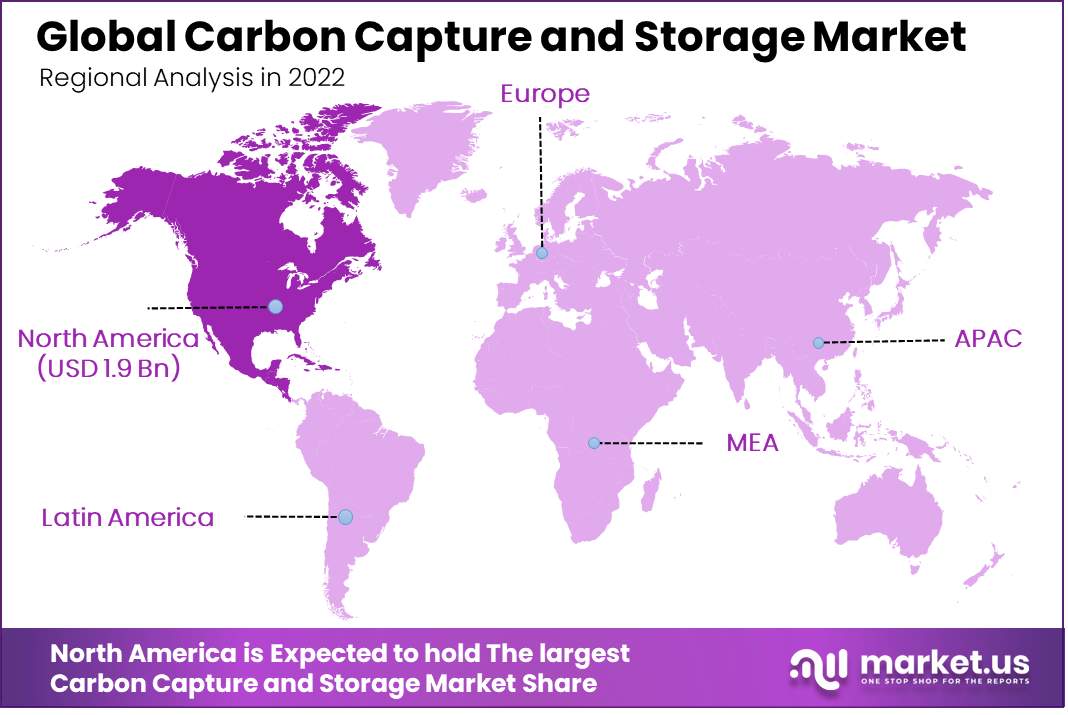Global Carbon Capture and Storage Market By Technology (Pre-combustion, Post-combustion, Oxy-combustion, and Industrial Process), By End-Use Industry (Power Generation, Oil & Gas, and Other End-Use Industries), By Region and Companies – Industry Segment Outlook, Market Assessment, Competition Scenario, Trends, and Forecast 2023 – 2032
- Published date: Oct 2023
- Report ID: 37076
- Number of Pages: 232
- Format:
- keyboard_arrow_up
Quick Navigation
Report Overview
In 2022, the Global Carbon Capture and Storage Market size was valued at USD 5.5 Billion. This market is estimated to reach USD 18.1 Billion in 2032 the highest CAGR of 13% between 2023 and 2032.
Carbon capture and storage is a process that involves the capture of carbon dioxide from the emissions of various steel and cement-producing industries or power generation plants that use fossil fuels.

The companies capture this carbon and transport it to the production site through pipelines or other transport ways like ships. It is then stored in deep undergrounds for geological formations. The carbon-capturing process produced by burning fossil fuels and other chemicals involves capturing and storing carbon dioxide so that it cannot affect the environment. It also helps to reduce the carbon footprint and prevents the rising global warming.
With the increasing population worldwide, the demand for goods and services is also continuously rising. These goods and services involve manufacturing processes that burn fossil fuels and generate carbon dioxide. Carbon dioxide is produced on a huge level worldwide due to increasing industrialization. This is growing the demand for carbon capture and storage. It also helps nature by reducing the carbon footprint and global warming. Due to this, many companies are entering the carbon capture and storage.
Key Takeaways
- Size and Growth: In 2022, the global carbon capture and storage market was valued at USD 5.5 billion and projected to increase at a compound annual growth rate of 13% between 2023-2032.
- Definition of Carbon Capture and Storage: Carbon capture and storage (CCS) refers to a process in which carbon emissions from industries and power plants powered by fossil fuels are captured, transported for storage at deep underground locations to mitigate any environmental damages and lower their carbon footprints.
- Driving Factors: Environmental Concerns As environmental awareness rises, so too do concerns over carbon emissions and environmental damage, driving carbon capture and storage technologies as environmentally friendly technologies. Gas Injection EOR Techniques Thanks to developments in enhanced oil recovery (EOR) techniques that utilize captured CO2, carbon capture is having an increasingly positive effect on market trends.
- Restraining Factors: Safety Concerns Carbon storage underground poses risks like soil acidification and pollution that must be carefully managed; while carbon capture and storage technologies require large investments that might make this option inaccessible for small to mid-sized companies.
- Technology Evaluation: Precombustion technology holds an impressive share of 65.8% for carbon capture and storage applications, due to its energy efficiency and superior CO2 capture abilities.
- End-Use Industry Analysis: Power generation dominated the end-use industry segment in 2013 with 64.6% revenue contribution. Government regulations to curb carbon emissions have led to greater adoption of carbon capture and storage technology within this segment of power production.
- Technological Advancements: Provide Growth Opportunities in Carbon Capture and Storage The advancements being made in carbon capture and storage present opportunities for the industry, creating growth prospects.
- Government Initiatives: Governments across various nations are making great strides toward carbon capture and storage technology to unlock growth potential in various ways.
- Recent Trends: Increase in Demand for Natural Gas As fossil fuel reserves decline, the trend towards natural gas due to its lower emissions is on the rise compared with oil and coal fuel sources; further driving carbon capture and storage demand.
- Regional Analysis: North America holds a 358 % revenue share of the global carbon capture and storage market due to strong oil and gas demand and tight regulations on carbon emissions.
- Europe’s Growth: Europe has experienced remarkable development of carbon capture and storage projects with innovative technologies.
- Key Players in Carbon Capture and Storage Market: Major companies operating in this space include Siemens AG, Aker Solutions, Dakota Gasification Company, Fluor Corp., Linde plc Mitsubishi Heavy Industries Ltd Equinor ASA Royal Dutch Shell PLC Sulzer Ltd Exxon Mobil Corporation amongst others are key participants of global carbon capture and storage industry.
Driving Factor
Rising Environmental Concerns and the Emergence of Gas Injection EOR Techniques Drive the Market Growth of Global Carbon Capture and Storage.
Rising concerns over carbon emissions and environmental harm are primarily driving the growth of carbon capture and storage. Increasing industrialization and urbanization worldwide have also increased the demand for every good and service. Due to this, industries are producing goods and services at a faster pace and with more emissions.
However, it is negatively affecting the environment and atmosphere of the Earth. Due to high carbon emissions, many environmental organizations have raised concerns. Therefore, carbon capture has emerged as an environmentally friendly technology for companies. It captures and stores the carbon dioxide that can help the environment from further harm. This is encouraging many companies to enter the carbon capture and storage market.
Also, the advancements in oil & gas carbon capture & storage market production activities have positively affected carbon capture and storage. The carbon is used in the gas injection enhanced oil recovery (EOR) techniques. In this technique, the carbon dioxide is used to extract crude oil. It is used in both the offshore and onshore gas extraction sites. With depleting oil reservoirs, the demand for gas injection (EOR) techniques is expected to rise significantly in the upcoming period. All these factors are propelling the growth of the global carbon capture and storage market.
Restraining Factor
Safety Concerns and the High Price of Technology are Restricting the Growth of the Global Carbon Capture and Storage.
The major restraining concern for the global carbon capture and storage market is carbon storage under the earth’s surface. In carbon dioxide storage under the earth’s surface, if the leakage happens in the storage, there are major chances of soil acidification, water poisoning, cryogenic burns, and change in the groundwater.
These hazards can occur on the carbon dioxide storage site under the earth’s surface. Therefore, it needs proper monitoring and precautions to avoid these hazards. These dangers of CO2 storage obstruct the growth of global carbon capture and storage. Also, the operation requires high investment in carbon capture and storage technology.
It involves many processes that require heavy processing; therefore, the cost of carbon capture and storage is relatively high in the market. This restricts many small and medium companies from adopting carbon capture and storage in their business.
By Technology Analysis
Pre-Combustion Dominates the Technology Segment by Covering Major Revenue Share.
Based on technology, global carbon capture and storage is classified into pre-combustion, post-combustion, oxy-combustion, and industrial process. From these technologies, pre-combustion technology dominates the segment by holding a major revenue share of 65.8%.
The increasing use of pre-combustion technology for CO2 capture by using the water gas shift reaction and removal with the help of acid gas removal is driving the growth of pre-combustion technology in the global carbon capture and storage market. The ability of pre-combustion technology to incur less energy penalty and more CO2 capture is boosting the growth of pre-combustion in the technology segment of the global carbon capture and storage.
By End-Use Industry Analysis
Power Generation Leads the End-Use Industry Segment by Holding the Major Revenue Share of 64.6%.
Based on the end-user industry, the global carbon capture and storage market is classified into power generation, oil & gas, metal production, cement, and other end-use industries. Power generation holds a major revenue share of 64.6% among these end-use industries, leading the end-use industry segment. Coal-fired power plants are the most carbon emitters.

Therefore, to reduce carbon emissions, governments have imposed heavy regulations to mandate that companies reduce carbon emissions. Therefore, many companies in power generation are starting carbon capture and storage operations. This propels power generation growth in the end-use industry segment of the global carbon capture and storage market.
Carbon Capture and Storage Key Market Segments
By Technology
- Pre-combustion
- Post-combustion
- Oxy-combustion
- Industrial Process
By End-Use Industry
- Power Generation
- Oil & Gas
- Metal Production
- Cement
- Other End-Use Industries
Growth Opportunity
Increasing Technological Advancements and Governmental Initiatives are Expected to Create Many Opportunities in the Global Carbon Capture and Storage Market.
With increasing advancements in carbon capture and storage technologies, many companies have started various projects for carbon capture and storage in Asia. Carbon usage in the oil & gas industry is forcing companies to create carbon capture and storage. Major key players in the Asia Pacific, specifically China, and Australia, have adopted carbon capture and storage early.
Therefore, increasing technological advancements will create many opportunities in the global carbon capture and storage over the forecast period. Also, increasing government support for carbon capture and storage encourages companies to adopt carbon capture and storage. The governments of many countries are taking various initiatives to promote carbon capture and storage within the country. This is also expected to create many global carbon capture and storage opportunities.
Latest Trends
With depleting fossil fuel reserves, the demand for natural gas is rising significantly. The emissions from burning natural gas are comparatively much less from burning oil and coal. It helps the environment by slowing global warming and reducing greenhouse gas emissions. Due to this, natural gas is considered a more practical option for fossil fuels. Therefore, the demand for natural gas is also expected to rise in the upcoming period, directly increasing the demand for carbon capture and storage.
Regional Analysis
North America Leads the Global Carbon Capture and Storage Market by Securing Major Revenue Share.
The North America region leads the global carbon capture and storage by covering a major revenue share of 35.8%. This domination of the North America region can be attributed to the region’s rising demand for oil & gas and strict governmental regulations to reduce carbon emissions. The United States and Canada are the major countries in the carbon capture and storage market.

Many key companies in these countries have started their companies’ carbon capture and storage. Moreover, with rising environmental concerns, organizations and governments have imposed stringent rules and regulations to control carbon emissions. This is propelling the carbon capture and storage market growth in the North America region.
After North America, Europe has the second largest share in the account. Increasing carbon capture and storage projects with innovative technologies are driving the growth of the Europe region in the global carbon capture and storage market.
Key Regions and Countries
- North America
- The US
- Canada
- Mexico
- Western Europe
- Germany
- France
- The UK
- Spain
- Italy
- Portugal
- Ireland
- Austria
- Switzerland
- Benelux
- Nordic
- Rest of Western Europe
- Eastern Europe
- Russia
- Poland
- The Czech Republic
- Greece
- Rest of Eastern Europe
- APAC
- China
- Japan
- South Korea
- India
- Australia & New Zealand
- Indonesia
- Malaysia
- Philippines
- Singapore
- Thailand
- Vietnam
- Rest of APAC
- Latin America
- Brazil
- Colombia
- Chile
- Argentina
- Costa Rica
- Rest of Latin America
- Middle East & Africa
- Algeria
- Egypt
- Israel
- Kuwait
- Nigeria
- Saudi Arabia
- South Africa
- Turkey
- United Arab Emirates
- Rest of MEA
Key Player Analysis
The global carbon capture and storage market is fragmented into many small and key players doing carbon capture and storage. Many of these companies are focusing on developing advanced technology to improve the efficiency of carbon capture and storage. Major players are adopting strategies like mergers, acquisitions, partnerships, and collaboration to expand their market share across various regions and strengthen their position in the market.
Some of the key players in the global carbon capture and storage market are Siemens AG, Aker Solutions, Dakota Gasification Company, Fluor Corp., Linde plc, Mitsubishi Heavy Industries Ltd., Equinor ASA, Royal Dutch Shell PLC, Sulzer Ltd., Exxon Mobil Corporation, and Other Key Players.
Top Key Players
- Siemens AG
- Aker Solutions
- Dakota Gasification Company
- Fluor Corp.
- Linde plc
- Mitsubishi Heavy Industries Ltd.
- Equinor ASA
- Royal Dutch Shell PLC
- Sulzer Ltd.
- Exxon Mobil Corporation
- Other Key Players
Recent Developments
- In December 2022, Malaysia state-owned oil and gas company Petroleum Sarawak Bhd collaborated with a Korean steel-making company, Posco Group, to develop business in the carbon capture and storage plant in Sarawak, Malaysia.
- In July 2021, Shell announced their plan to build a large carbon capture and storage project in Alberta, Canada. This project will capture nearly 300 million tons of carbon dioxide from the shell’s refineries and chemical plants.
Report Scope
Report Features Description Market Value (2022) USD 5.5 Bn Forecast Revenue (2032) USD 18.1 Bn CAGR (2023-2032) 13 % Base Year for Estimation 2022 Historic Period 2016-2022 Forecast Period 2023-2032 Report Coverage Revenue Forecast, Market Dynamics, COVID-19 Impact, Competitive Landscape, Recent Developments Segments Covered By Technology – Pre-combustion, Post-combustion, Oxy-combustion, and Industrial Process; By End-Use Industry – Power Generation, Oil & Gas, Metal Production, Cement, and Other End-Use Industries Regional Analysis North America – The US, Canada, & Mexico; Western Europe – Germany, France, The UK, Spain, Italy, Portugal, Ireland, Austria, Switzerland, Benelux, Nordic, & Rest of Western Europe; Eastern Europe – Russia, Poland, The Czech Republic, Greece, & Rest of Eastern Europe; APAC – China, Japan, South Korea, India, Australia & New Zealand, Indonesia, Malaysia, Philippines, Singapore, Thailand, Vietnam, & Rest of APAC; Latin America – Brazil, Colombia, Chile, Argentina, Costa Rica, & Rest of Latin America; The Middle East & Africa – Algeria, Egypt, Israel, Kuwait, Nigeria, Saudi Arabia, South Africa, Turkey, United Arab Emirates, & Rest of MEA Competitive Landscape Siemens AG, Aker Solutions, Dakota Gasification Company, Fluor Corp., Linde plc, Mitsubishi Heavy Industries Ltd., Equinor ASA, Royal Dutch Shell PLC, Sulzer Ltd., Exxon Mobil Corporation, and Other Key Players Customization Scope Customization for segments, region/country-level will be provided. Moreover, additional customization can be done based on the requirements. Purchase Options We have three licenses to opt for: Single User License, Multi-User License (Up to 5 Users), Corporate Use License (Unlimited User and Printable PDF) Frequently Asked Questions (FAQ)
What is the value of the global Carbon Capture and Storage Market?In 2022, the global Carbon Capture and Storage Market was valued at USD 5.5 billion.
What will be the market size for Carbon Capture and Storage Market in 2032?In 2032, the Carbon Capture and Storage Market will reach USD 18.1 billion.
What CAGR is projected for the Carbon Capture and Storage Market?The Carbon Capture and Storage Market is expected to grow at 13% CAGR (2023-2032).
List the segments encompassed in this report on the Carbon Capture and Storage Market?Market.US has segmented the Carbon Capture and Storage Market Market by geographic (North America, Europe, APAC, South America, and MEA). By Technology, market has been segmented into Pre-combustion, Post-combustion, Oxy-combustion and Industrial Process. By End-Use Industry, the market has been further divided into Power Generation, Oil & Gas, Metal Production, Cement and Other End-Use Industries.
Which segment dominate the Carbon Capture and Storage industry?With respect to the Carbon Capture and Storage industry, vendors can expect to leverage greater prospective business opportunities through the Pre-Combustion segment, as this dominate this industry.
Name the major industry players in the Carbon Capture and Storage Market.Siemens AG, Aker Solutions, Dakota Gasification Company, Fluor Corp., Linde plc, Mitsubishi Heavy Industries Ltd. and Other Key Players are the main vendors in this market.
 Carbon Capture and Storage MarketPublished date: Oct 2023add_shopping_cartBuy Now get_appDownload Sample
Carbon Capture and Storage MarketPublished date: Oct 2023add_shopping_cartBuy Now get_appDownload Sample - Siemens AG
- Aker Solutions
- Dakota Gasification Company
- Fluor Corp.
- Linde plc
- Mitsubishi Heavy Industries Ltd.
- Equinor ASA
- Royal Dutch Shell PLC
- Sulzer Ltd.
- Exxon Mobil Corporation Company Profile
- Other Key Players
- settingsSettings
Our Clients
| Single User $4,599 $3,499 USD / per unit save 24% | Multi User $5,999 $4,299 USD / per unit save 28% | Corporate User $7,299 $4,999 USD / per unit save 32% | |
|---|---|---|---|
| e-Access | |||
| Report Library Access | |||
| Data Set (Excel) | |||
| Company Profile Library Access | |||
| Interactive Dashboard | |||
| Free Custumization | No | up to 10 hrs work | up to 30 hrs work |
| Accessibility | 1 User | 2-5 User | Unlimited |
| Analyst Support | up to 20 hrs | up to 40 hrs | up to 50 hrs |
| Benefit | Up to 20% off on next purchase | Up to 25% off on next purchase | Up to 30% off on next purchase |
| Buy Now ($ 3,499) | Buy Now ($ 4,299) | Buy Now ($ 4,999) |












